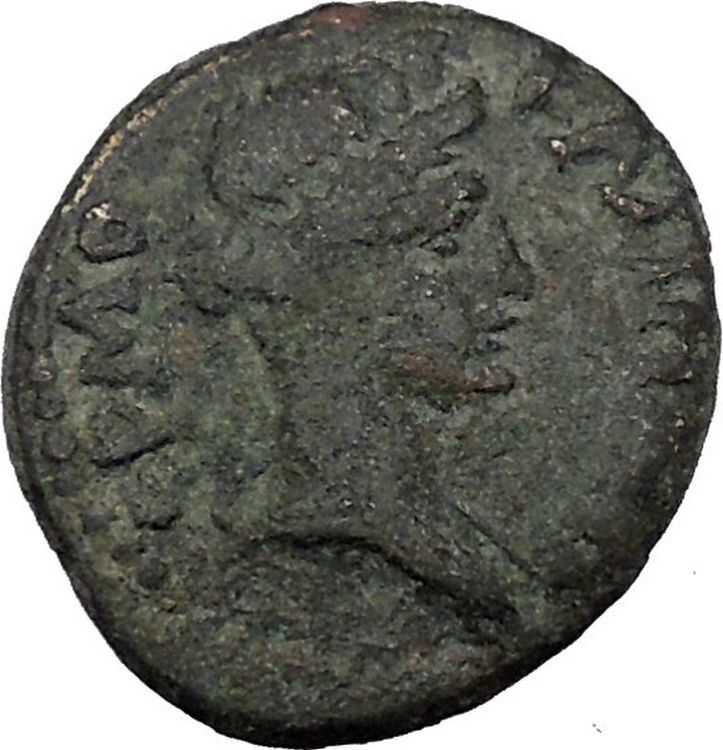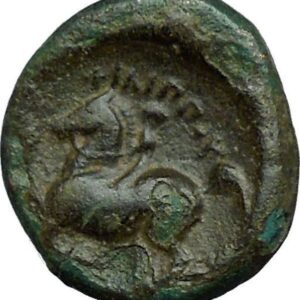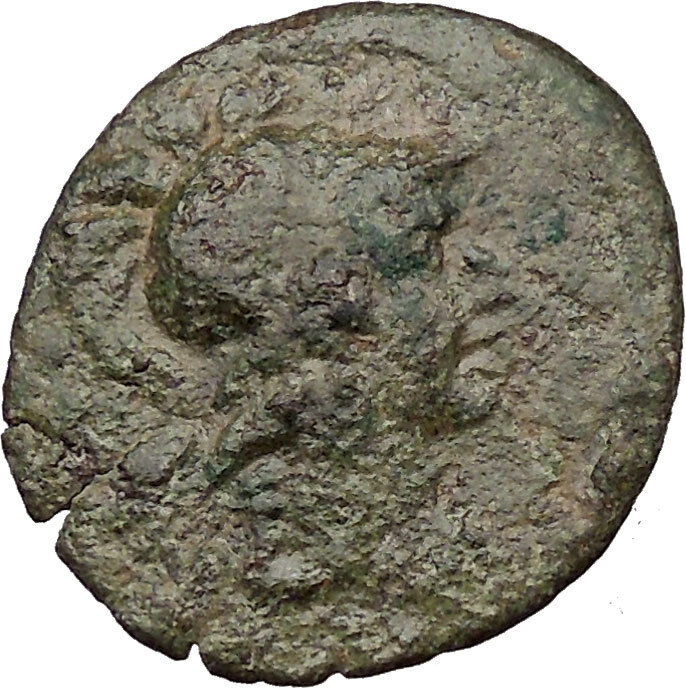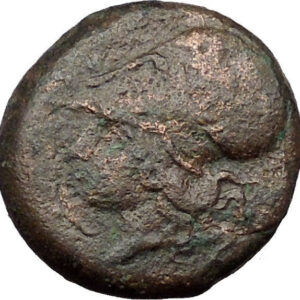|
Greek city of Odessos in Thrace
Bronze 12mm (2.47 grams) Struck circa 281-188 B.C.
Reference: cf. Sear 1680; SNG BMC Black Sea 294; SNG Stancomb 254;
SNG Copenhagen 669; Topalov, Odesos 20; Laffaille -.
Diademed head of youth right.
The Great God Derzelas reclining left on plinth inscribed ΟΔΗΣΙΤΩΝ, inverted amphora
and monogram in left field.
You are bidding on the exact item pictured, provided with a Certificate of Authenticity and Lifetime Guarantee of Authenticity.
Derzelas (Darzalas) was a Dacian or Thracian chthonic god of abundance and the underworld, health and human spirit’s vitality, probably related with gods such as Hades, Zalmoxis, Gebeleizis.
Darzalas was the Great God of Hellenistic Odessos (modern Varna) and was frequently depicted on its coinage from the 3rd century BCE to the 3rd century CE and portrayed in numerous terra cotta figurines, as well as in a rare 4th century BC lead one (photo), found in the city. Darzalas was often depicted in himation, holding cornucopiae with altars by his side. There was a temple dedicated to him with a cult statue, and games (Darzaleia) were held in his honor every five years, possibly attended by Gordian III in 238 AD.
Another temple dedicated to Derzelas was built at Histria (Sinoe) – a Greek colony, on the shore of the Black Sea in the 3rd century BC.
Darzalas Peak on Trinity Peninsula in Antarctica is named after the god.
An amphora (plural: amphorae or amphoras) is a type of vase-shaped, usually ceramic (specimens in materials such as metal occur occasionally) container with two handles and a long neck narrower than  the body. The word amphora is Latin, derived from the Greek amphoreus (αμφορεύς), an abbreviation of amphiphoreus, a compound word combining amphi- (“on both sides”, “twain”) plus phoreus (“carrier”), from pherein (“to carry”), referring to the vessel’s two carrying handles on opposite sides. the body. The word amphora is Latin, derived from the Greek amphoreus (αμφορεύς), an abbreviation of amphiphoreus, a compound word combining amphi- (“on both sides”, “twain”) plus phoreus (“carrier”), from pherein (“to carry”), referring to the vessel’s two carrying handles on opposite sides.
Further, the term also stands for an ancient Roman unit of measurement for liquids. The volume of a Roman amphora was one cubic foot, ca. 26,026 L.
Amphorae were used in vast numbers to transport and store various products, both liquid and dry, in the ancient Mediterranean world and later the Roman Empire, and in some periods the shape was also used for luxury pottery, which might be elaborately painted. Stoppers of perishable materials which have rarely survived were used to seal the contents. Two principal types of amphorae existed: the neck amphora, in which the neck and body meet at a sharp angle; and the one-piece amphora, in which the neck and body form a continuous curve. Neck amphorae were commonly used in the early history of ancient Greece but were gradually replaced by the one-piece type from around the 7th century BCE onwards. Most were produced with a pointed base to allow upright storage by being partly embedded in sand or soft ground. This also facilitated transport by ship, where the amphorae were tightly packed together, with ropes passed through their handles to prevent breaking or toppling during rough seas. In kitchens and shops amphorae could be stored in racks with round holes in them.
Amphorae varied greatly in height. The largest could stand as much as 1.5 metres (5 ft) high, while some were under 30 centimetres (12 in) high – the smallest were called amphoriskoi (literally “little amphorae”). Most were around 45 centimetres (18 in) high. There was a significant degree of standardisation in some variants; the wine amphora held a standard measure of about 39 litres (41 US qt), giving rise to the amphora quadrantal as a unit of measure in the Roman Empire. In all, around 66 distinct types of amphora have been identified.
Thrace (demonym Thracian /ənθreɪʃⁱˈ/; Bulgarian: Тракия, Trakiya, Greek: Θράκη, Thráki, Turkish: Trakya) is a historical and geographic area in southeast Europe. As a geographical concept, Thrace designates a region bounded by the Balkan Mountains on the north, Rhodope Mountains and the Aegean Sea on the south, and by the Black Sea and the Sea of Marmara on the east. The areas it comprises are southeastern Bulgaria (Northern Thrace), northeastern Greece (Western Thrace), and the European part of Turkey (Eastern Thrace). The biggest part of Thrace is part of present-day Bulgaria. In Turkey, it is also called Rumelia. The name comes from the Thracians, an ancient Indo-European people inhabiting Southeastern Europe.
The historical boundaries of Thrace have varied. Noteworthy is the fact that, at an early date, the ancient Greeks employed the term “Thrace” to refer to all of the territory which lay north of Thessaly inhabited by the Thracians, a region which “had no definite boundaries” and to which other regions (like Macedonia and even Scythia) were added. In one ancient Greek source, the very Earth is divided into “Asia, Libya, Europa and Thracia”. As the knowledge of world geography of the Greeks broadened, the term came to be more restricted in its application: Thrace designated the lands bordered by the Danube on the north, by the Euxine Sea (Black Sea) on the east, by northern Macedonia in the south and by the Illyrian lands (i.e. Illyria) to the west. This largely coincided with the Thracian Odrysian kingdom, whose borders varied in time. During this time, specifically after the Macedonian conquest, the region’s old border with Macedonia was shifted from the Struma River to the Mesta River. This usage lasted until the Roman conquest. Henceforth, (classical) Thrace referred only to the tract of land largely covering the same extent of space as the modern geographical region. In its early period, the Roman province of Thrace was of this extent, but after the administrative reforms of the late 3rd century, Thracia’s much reduced territory became the six small provinces which constituted the Diocese of Thrace. The medieval Byzantine theme of Thrace contained only what today is Eastern Thrace.
The largest cities of Thrace are: İstanbul (European side), Plovdiv, Burgas, Stara Zagora, Haskovo, Edirne, Çorlu and Tekirdag.
Most of the Bulgarian and Greek population are Christians, while most of the Turkish inhabitants of Thrace are Muslims.
Thrace in ancient Greek mythology
Ancient Greek mythology provides them with a mythical ancestor, named Thrax, son of the war-god Ares, who was said to reside in Thrace. The Thracians appear in Homer‘s Iliad as Trojan allies, led by Acamas and Peiros. Later in the Iliad, Rhesus, another Thracian king, makes an appearance. Cisseus, father-in-law to the Trojan elder Antenor, is also given as a Thracian king. Homeric Thrace was vaguely defined, and stretched from the River Axios in the west to the Hellespont and Black Sea in the east. The Catalogue of Ships mentions three separate contingents from Thrace: Thracians led by Acamas and Peiros, from Aenus; Cicones led by Euphemus, from southern Thrace, near Ismaros; and from the city of Sestus, on the Thracian (northern) side of the Hellespont, which formed part of the contingent led by Asius. Greek mythology is replete with Thracian kings, including Diomedes, Tereus, Lycurgus, Phineus, Tegyrius, Eumolpus, Polymnestor, Poltys, and Oeagrus (father of Orpheus). In addition to the tribe that Homer calls Thracians, ancient Thrace was home to numerous other tribes, such as the Edones, Bisaltae, Cicones, and Bistones.
Thrace is also mentioned in Ovid’s Metamorphoses in the episode of Philomela, Procne, and Tereus. Tereus, the King of Thrace, lusts after his sister-in-law, Philomela. He kidnaps her, holds her captive, rapes her, and cuts out her tongue. Philomela manages to get free, however. She and her sister, Procne, plot to get revenge, by killing Itys (son of Tereus and Procne) and serving him to his father for dinner. At the end of the myth, all three turn into birds—Procne, a swallow; Philomela, a nightingale; and Tereus, a hoopoe.
History
Ancient history
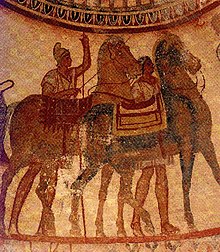
Thracian Tomb of Kazanlak
The indigenous population of Thrace was a people called the Thracians, divided into numerous tribal groups. Thracian troops were known to accompany neighboring ruler Alexander the Great when he crossed the Hellespont which abuts Thrace, and took on the Persian Empire of the day.
The Thracians did not describe themselves as such and Thrace and Thracians are simply the names given them by the Greeks.
Divided into separate tribes, the Thracians did not manage to form a lasting political organization until the Odrysian state was founded in the 4th century BC. Like Illyrians, Thracian tribes of the mountainous regions fostered a locally ruled warrior tradition, while the tribes based in the plains were purportedly more peaceable. Recently discovered funeral mounds in Bulgaria suggest that Thracian kings did rule regions of Thrace with distinct Thracian national identity.
During this period, a subculture of celibate ascetics called the Ctistae lived in Thrace, where they served as philosophers, priests and prophets.
Medieval history
By the mid 5th century, as the Roman Empire began to crumble, Thracia fell from the authority of Rome and into the hands of Germanic tribal rulers. With the fall of Rome, Thracia turned into a battleground territory for the better part of the next 1,000 years. The eastern successor of the Roman Empire in the Balkans, the Byzantine Empire, retained control over Thrace until the 8th century when the northern half of the entire region was incorporated into the First Bulgarian Empire. Byzantium regained Thrace in the late 10th century and administered it as a theme, until the Bulgarians regained control of the northern half at the end of the 12th century. Throughout the 13th century and the first half of the 14th century, the region was changing in the hands of the Bulgarian and the Byzantine Empire(excl. Constantinopole). In 1265 the area suffered a Mongol raid from the Golden Horde, led by Nogai Khan. In 1352, the Ottoman Turks conducted their first incursion into the region subduing it completely within a matter of two decades and occupying it for five centuries.
Modern history
With the Congress of Berlin in 1878, Northern Thrace was incorporated into the semi-autonomous Ottoman province of Eastern Rumelia, which united with Bulgaria in 1885. The rest of Thrace was divided among Bulgaria, Greece and Turkey at the beginning of the 20th century, following the Balkan Wars, World War I and the Greco-Turkish War. Today Thracian is a strong regional identity in Greece, Turkey, Bulgaria and other neighbouring countries.
Famous Thracians and people from Thrace
- Mehmed II Ottoman Sultan, born at Edirne in Thrace; he was the Sultan who conquered Constantinople, marking the end of the Middle Ages.
- Bayezid II Ottoman Sultan
- Spartacus was a Thracian auxiliary soldier in the Roman army who deserted but was captured and then enslaved by the Romans. He led a large slave uprising in what is now Italy in 73–71 BC. His army of escaped gladiators and slaves defeated several Roman legions in what is known as the Third Servile War.
- Belisaurius, one of the most successful Generals of the Roman Empire, was born in the borderlands between Thrace and Illyria.
- In Ancient Greek mythology, Orpheus was the chief representative of the art of song and playing the lyre.
- Democritus was a Greek philosopher and mathematician from Abdera, Thrace (c. 460–370 BC.) His main contribution is the atomic theory, the belief that all matter is made up of various imperishable indivisible elements which he called atoms.
- Herodicus was a Greek physician of the fifth century BC who is considered the founder of sports medicine. He is believed to have been one of Hippocrates’ tutors.
- Protagoras was a Greek philosopher from Abdera, Thrace (c. 490–420 BC.) An expert in rhetorics and subjects connected to virtue and political life, often regarded as the first sophist. He is known primarily for three claims (1) that man is the measure of all things, often interpreted as a sort of moral relativism, (2) that he could make the “worse (or weaker) argument appear the better (or stronger)” (see Sophism) and (3) that one could not tell if the gods existed or not (see Agnosticism).
- A number of Roman emperors of the 3rd-5th century were of Thraco-Roman backgrounds (Maximinus Thrax, Licinius, Galerius, Aureolus, Leo the Thracian, etc.). These emperors were elevated via a military career, from the condition of common soldiers in one of the Roman legions to the foremost positions of political power.
|





 the body. The word amphora is Latin, derived from the Greek amphoreus (
the body. The word amphora is Latin, derived from the Greek amphoreus (


